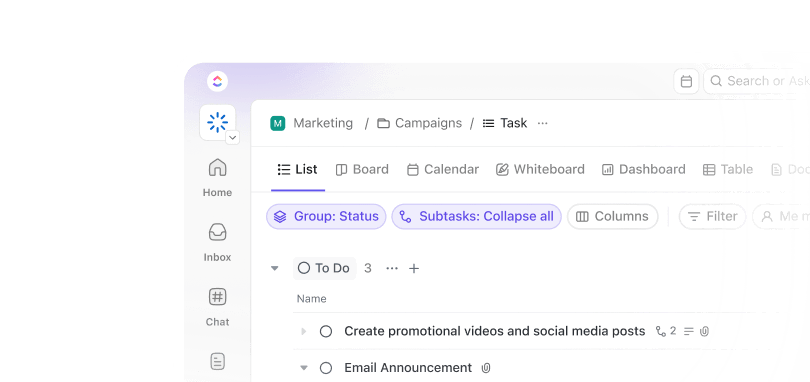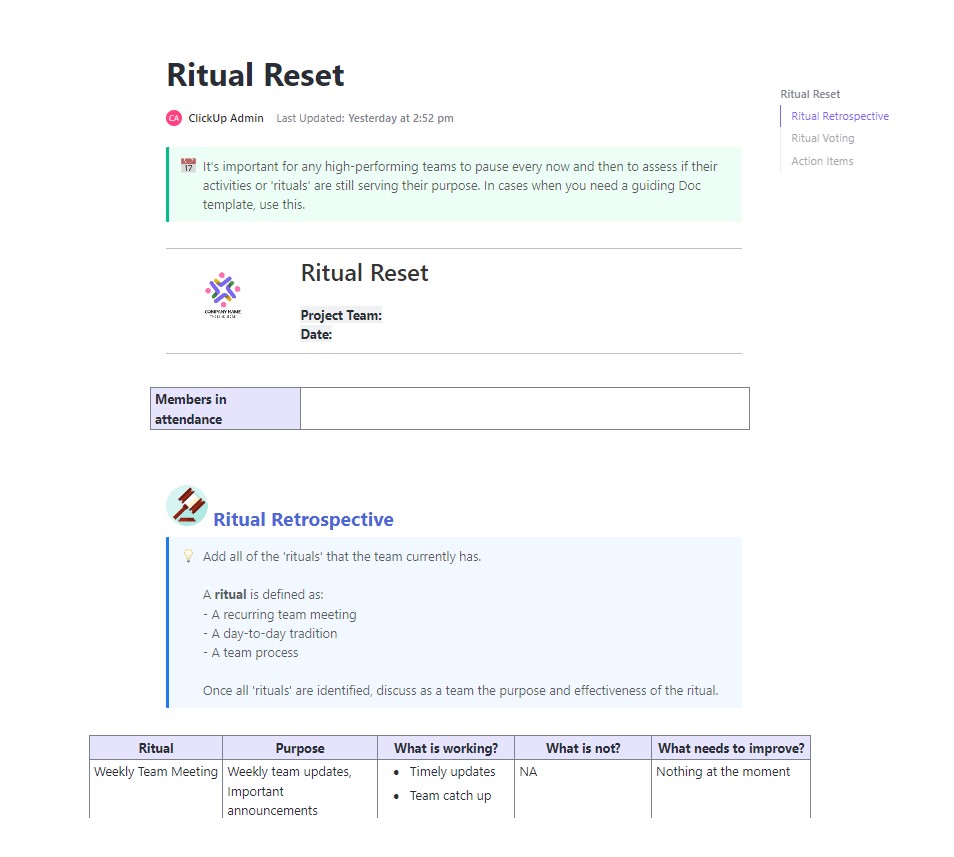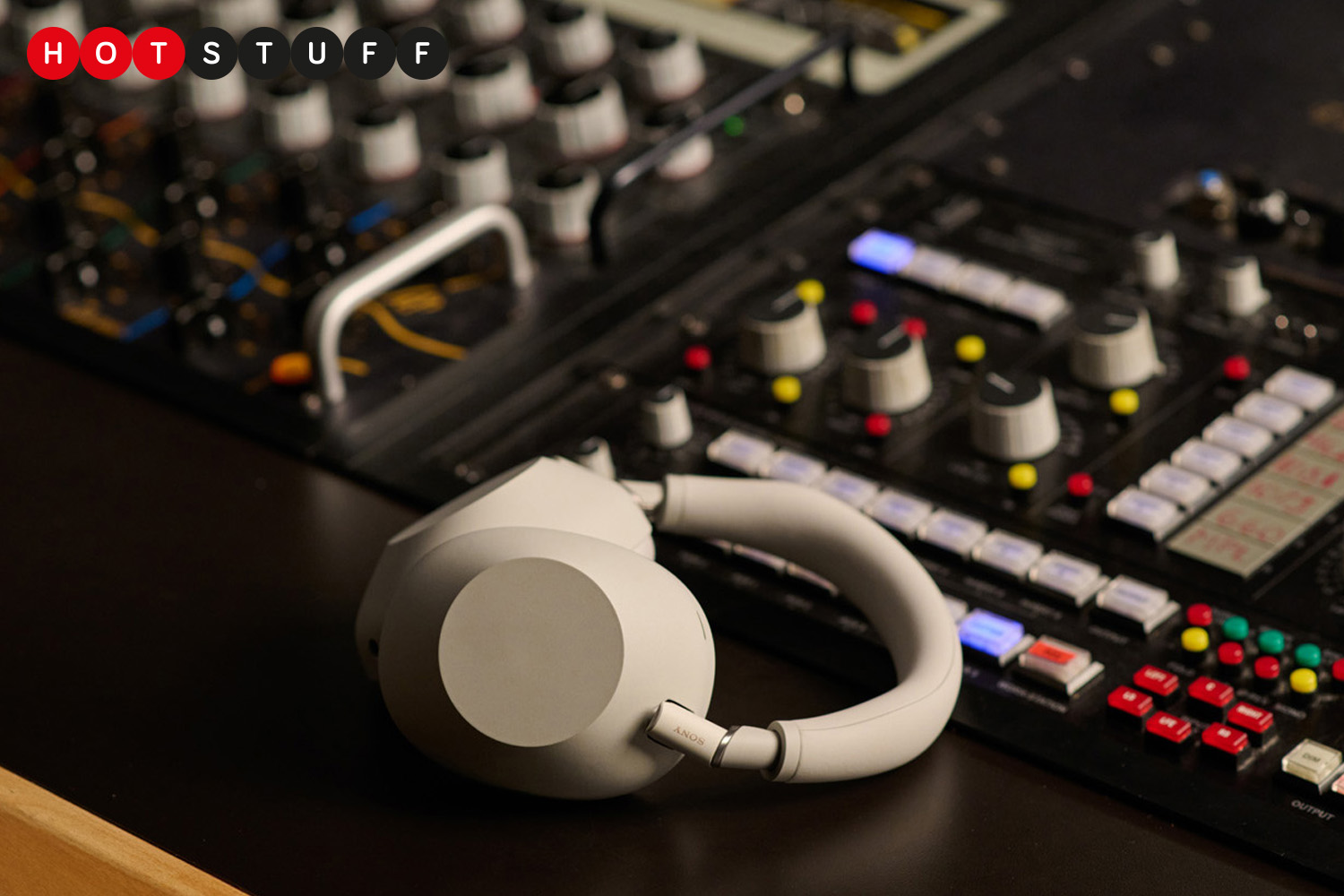Every team builds rituals. The smart ones know when to break them.
A ritual reset is how you cut the noise, reclaim your time, and rebuild routines that actually serve the work, and not just fill the calendar.
This isn’t about productivity hacks. It’s about creating space to think, reset, and move with purpose again.
⏰ 60-Second Summary
Rituals shape how your team works, but progress can be hindered when they stop evolving. Here’s how to run a ritual reset that clears the clutter and restores focus:
- Identify what’s no longer working by auditing your current rituals, weekly rhythms, and team feedback
- Define an ideal routine that supports focus, flexibility, and clarity—without overloading the calendar
- Use tools like ’s Calendar, Dashboards, Automations, Goals, and Reminders to keep your reset structured and consistent
- Make ritual resets a recurring habit, not a one-off fix, so your systems stay aligned with your team’s real pace and priorities
A well-timed ritual reset won’t just clean up your workflow; it’ll help your team work with purpose, not just momentum.
Ritual Reset: How to Refresh Your Habits & Improve Productivity.
What is a Ritual Reset?
A ritual reset is a deliberate pause to step back, assess your current rituals, and reshape them with intention. It’s not about throwing out everything and starting fresh, rather, it’s about refining the rhythms that guide how your team works.
Over time, even the best rituals become outdated. What once boosted energy, focus, or alignment can slowly turn into background noise. That’s where a ritual reset steps in, to recalibrate without chaos.
It helps you:
- Make room for more creative thinking, or better workflows
- Examine how your team spends its time and attention
- Eliminate rituals that feel forced or disconnected
- Reinforce the ones that create value or momentum
Think of it like updating a shared document that’s been edited too many times before it becomes messy and hard to follow. You’re not rewriting the entire thing. You’re restoring clarity.
A ritual reset can apply to your team meetings, your Monday priorities, your end-of-week reflection, or even your project planning flow. The scale doesn’t matter, what matters is the impact.
It’s a form of systems maintenance. It helps your team stay aligned, your processes stay relevant, and your habits stay intentional. And when done regularly, it builds the kind of structure that actually gives you more freedom.
Signs You Need a Ritual Reset
Rituals lose their value when they stop evolving. The signs aren’t always dramatic, more often, they show up in small moments your team has learned to ignore.
Instead of efficiency, you get motion without direction. Instead of clarity, you get noise disguised as structure. A ritual reset becomes necessary when your systems start dragging instead of driving momentum.
Progress feels vague, even when work is constant
You’re busy but the outcomes aren’t obvious. Tasks are being completed, calendars are full, but it’s hard to point to what’s actually being achieved.
It’s not that people aren’t trying. It’s that the processes guiding them have lost relevance.
You’ll notice:
- Recurring meetings that feel more like habits than decision points
- Weekly goals that are checked off without a clear impact
- Your to-do list growing faster than it’s being cleared
Your team’s energy and attention are scattered
Even high-performing teams lose rhythm when rituals no longer reflect their reality. Instead of adapting to shifting priorities, they stay locked in outdated routines.
What this looks like:
- Mid-week energy dips that feel baked into the culture
- Creative tasks getting pushed aside for recurring low-priority work
- Internal tools or dashboards are being ignored because they no longer feel useful
Without intervention, this leads to burnout not because of too much work, but because the structure no longer supports the work being done.
👀 Did You Know? The term “burnout” was first coined in 1974 by psychologist Herbert Freudenberger. This was done after watching idealistic volunteers at a free clinic slowly lose their drive.
Burnout didn’t start in corporate boardrooms, it started with people who cared too much for too long, without enough recovery.
There’s friction where there used to be flow
You’ll hear it in conversations: “This is just how we do things.”
That mindset signals the biggest gap, a lack of reflection and intentional change. The team keeps moving, but not necessarily in the right direction.
A ritual reset opens space to:
- Reflect on routines that no longer serve a purpose
- A spot where tools, meetings, or cycles have become performative
- Rebuild the structure around how your team actually works now, not how it worked six months ago
Ignoring these signals costs more than time. It leads to lost focus, misaligned momentum, and the slow decay of high performance.
The earlier you spot them, the less drastic your reset needs to be. Small, intelligent changes now can save hours every week and bring your team back into sync.
How to Perform a Ritual Reset?
A ritual reset works best when it’s structured, intentional, actionable, and not abstract.
These four steps will help you break down what’s no longer serving your team, rebuild with purpose, and design rituals that actually drive progress.
Step 1: Identify what’s not working
By the time you notice symptoms like low engagement, poor focus, or dropped rituals, the system’s already out of sync.
This step is about getting underneath the surface. Not just spotting the friction, but understanding where your team’s current structure is misaligned with how they actually work.
Start with a clean audit. Don’t just list your existing rituals, rather classify them into these categories:
- Essential: Still energizing and connected to outcomes
- Optional: Sometimes useful, but not always needed
- Outdated: Draining time or energy without delivering value
This helps you isolate what’s worth keeping and what’s quietly slowing your team down.
To go deeper, map your team’s energy across a typical week. Where do things flow easily? When does progress stall? This gives you insight into whether your rituals are reinforcing natural momentum or fighting against it.
📮 Insight: Over 60% of a team’s time is spent searching for context, information, and action items.
According to research by , teams lose precious hours jumping between different tools. To prevent broken communication, integrate messaging into your workflows with a centralized platform that unites project management, collaboration, and communication.
Try , the everything app for work.
You can also gather feedback by prompting your team with a few focused questions:
- What part of your week feels the most structured?
- Where do you find yourself skipping steps or going off-track?
- Are there rituals you’ve outgrown, or ones you wish existed?
This isn’t about tearing things down. It’s about creating a shared understanding of what’s not working anymore, so the reset is built on clarity and not assumption.
Step 2: Define your ideal routine
This is where things shift from identifying the drag to designing your flow. Your team already has rituals. But if you’re rebuilding, don’t default to what looks good on a calendar.
Focus on what actually helps your team create, achieve, and stay in sync without overload.
Think of your routine as scaffolding. It should hold up deep work, clean handoffs, and space to reflect, not just block off hours.
Start with your anchors. These are the rituals that create momentum:
- Do a Monday kickstart to align priorities and energy
- Keep a mid-week pulse check to catch what’s slipping
- Arrange for a Friday wind-down to review what worked and what didn’t
Don’t stop at the obvious. Great routines also protect focus:
- A shared morning block for heads-down work
- Creative windows where no meetings are allowed
- Open space for the team to regroup or rethink without pressure
📌 Example
One team replaced their standing Monday check-in with a shared doc where each person updated their to-do list and weekly focus before noon.
They followed it with a short sync call, only if needed. The meeting didn’t disappear; it just became lighter, sharper, and more useful.
Now zoom out. Does this routine reflect how your team actually works or how it used to? Where are you repeating rituals that have no clear intention? Where are people working against the clock instead of with it?
A solid routine isn’t rigid. It’s responsive. It adapts to energy patterns, project rhythms, and the pace your team can sustain. And most importantly, it leaves room to breathe.
Step 3: Use tools to stay accountable
A ritual reset only works if your new rhythms stick. But with the pace of day-to-day execution, even well-designed routines can slip without the right support system.
That’s where the right tools help by embedding structure into the flow of work. Here’s how to build accountability into your rituals without micromanaging your team.
Visualize your time and priorities

It’s hard to stick to a rhythm if no one knows what it looks like. Before the week even begins, your rituals should have a clear home on the calendar.
Use Calendar to map everything, from your Monday priorities to shared no-meeting focus blocks.
Everyone sees the plan, and more importantly, respects the time that’s been protected for deep work, regrouping, or re-alignment.
Track progress where it matters


Rituals are only as useful as the outcomes they support. The more visible the progress, the more likely your team is to stay consistent.
Dashboards give you a real-time view of what’s moving and what’s not. Whether you’re tracking key tasks, active projects, or overall team engagement, Dashboards turn your routines into measurable systems—not just habits.
Automate the repeatable
The most sustainable rituals are the ones that don’t need constant reminders to happen. Automations let you build structure into the background.
Automatically assign recurring reviews, trigger updates after standups, or move tasks forward when the right condition is met. Less chasing, more flow.
Stay aligned with shared goals


It’s easy for routines to turn into checklists if no one sees how they tie back to something meaningful.
With Goals, you can connect your rituals to real outcomes, whether it’s project milestones, team OKRs, or weekly check-ins. Your team isn’t just going through the motions. They’re moving toward something that matters.
Make it hard to forget the important stuff
Even with the best structure, things fall through the cracks. That’s normal. What matters is whether your system catches them.
Use Reminders to reinforce what matters most, whether it’s a quick moment to reflect on your week, prep for a reset, or follow up on a blocker.
Want a plug-and-play ritual reset?
The Ritual Reset Template gives you a jumpstart without the requirement of any whiteboard.
Here’s why it works:
- Helps you review and rebuild your current rituals with the intention
- Offers ready-to-go task structures for recurring check-ins and reflections
- Keeps everything organized—from meetings to reviews to routines
You can also layer in the Personal Habit Tracker Template to reinforce individual consistency alongside the team rhythm.
Step 4: Build consistency and avoid burnout
Resetting is the easy part. Keeping the rhythm alive? That’s where it gets real.
Consistency doesn’t mean sticking to rigid routines. It means creating rituals that evolve with your team’s energy, priorities, and momentum. When your structure is too tight, it breaks. When it’s too loose, it disappears.
You want the sweet spot—a flexible structure that sticks.
Start by normalizing the reset itself
If your rituals are sacred, they’re also reviewable. Make it normal to pause, ask “Is this still working?” and shift when needed. The reset shouldn’t be a last resort. It should be part of the system.
Build rituals that breathe
Not every ritual needs to be a standing meeting or a fixed checklist. Some are quiet, some are solo, and some are about not doing.
Here’s what breathing rituals look like:
- A bit of silence before jumping into the day
- Dropping one task mid-week to create more space
- Replacing an end-of-day check-in with a moment to reflect, not report
These don’t break the flow. They restore it.
👀 Did You Know? In Japan, there’s a word for death by overwork called, “karōshi“. It’s a recognized occupational phenomenon and a stark reminder that burnout doesn’t always come from chaos. Sometimes, it comes from too much routine without pause.


Design for energy, not just output
Want to avoid burnout? Watch how your team feels, not just what they produce.
Use the reset to spot patterns:
- Are there points in the week where energy crashes?
- Are rituals helping people stay focused—or just filling time?
- Is anyone dragging through the rhythm instead of moving with it?
If the answer is yes, it’s time to re-evaluate. Small shifts now prevent bigger breakdowns later.
Let the rituals evolve
The biggest trap? Thinking your reset is finished. Rituals aren’t static—they’re living systems. Let them grow with the team.
Protect what’s working. Drop what’s not. And always leave space for the unexpected. Because the real magic of a ritual reset isn’t in how you start. It’s in how you keep showing up without burning out.
Best practices for an effective ritual reset
You’ve redesigned the rhythm. Now it’s time to operationalize it.
These practices aren’t about keeping rituals consistent. They’re about keeping them resilient. So they scale with your team, stay relevant under pressure, and evolve without losing their core purpose.
1. Assign ritual owners and not just participants
Every recurring ritual should have someone responsible for its health. That person doesn’t need to run it, they just need to care if it’s working. Ownership drives reflection, iteration, and longevity.
Examples:
- One owner per team-wide ritual (e.g. kickoff, reviews)
- Rotating owners for standups or retros
- Clear responsibility for sunsetting rituals when they stop adding value
This builds accountability into the culture.
2. Set clear success signals
If your team can’t tell when a ritual is effective, it won’t stick.
Define what success looks like:
- What outcomes should this ritual support?
- Do we have any certain behaviors that it should reinforce?
- What would make us stop doing it?
Success signals create clarity and help you avoid rituals that just go through the motions.
3. Review across layers, not just timelines
Most teams review rituals by schedule, weekly, monthly, and quarterly.
Go deeper:
- Are our processes aligned across teams or pulling in different directions?
- Do we run the same ritual three different ways in three different groups?
- Are we optimizing the ritual or the workflow behind it?
This keeps your system integrated, not fragmented.
4. Track drift and not simply performance
A ritual might still be happening, but not how it was intended. Maybe it runs longer, or it’s rushed. Maybe half the group checks out.
Track where things have drifted from their original design. That’s where the gaps begin and where resets need to happen before things break down.
5. Build rituals into onboarding
Want your reset to last? Bake it into how new hires learn to work with your team. Introduce core rituals during onboarding—not just what they are, but why they exist. It turns cultural memory into shared muscle.
Make Ritual Resets a Normal Part of Work
A ritual reset gives you more than just cleaner workflows. It brings your team back to work that feels aligned with your goals, your life, and the way your team actually operates as a body, not just a list of tasks.
Use it as a regular moment to discuss what’s working and what’s not, before the friction builds. The more space you create for alignment, the easier it becomes to sustain momentum.
Try today and turn your team’s rituals into a system that supports real progress.


Everything you need to stay organized and get work done.














